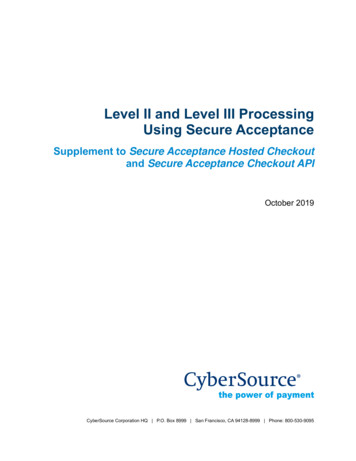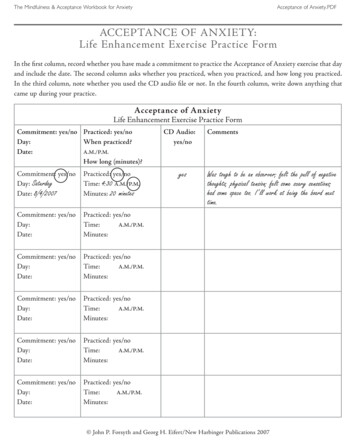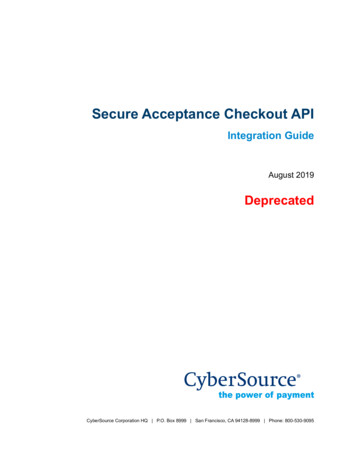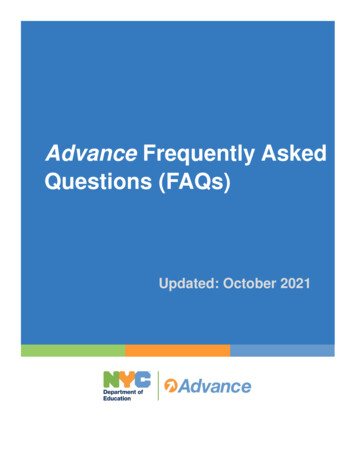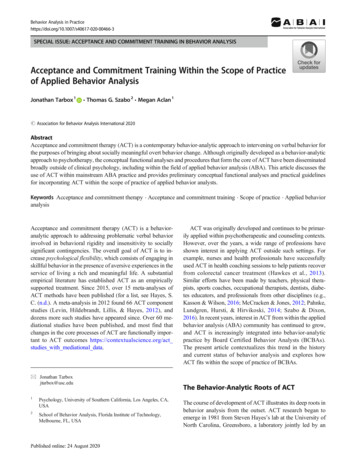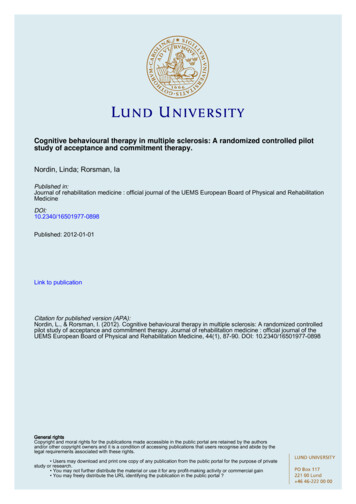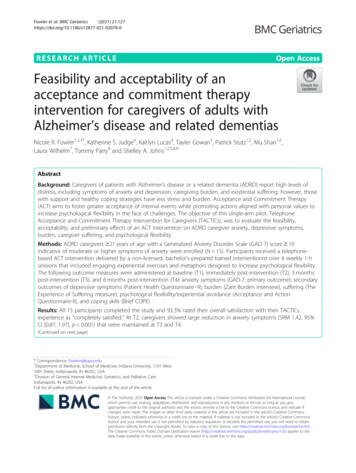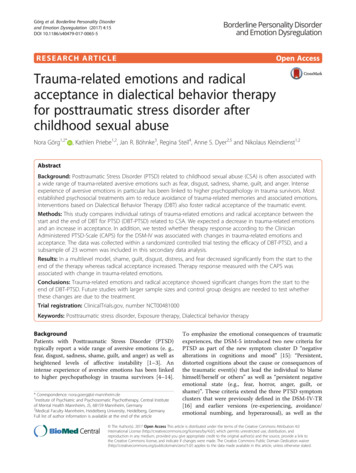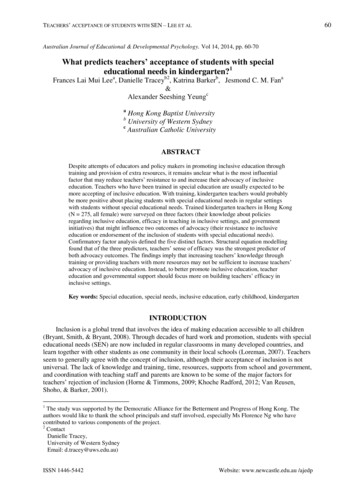
Transcription
TEACHERS’ ACCEPTANCE OF STUDENTS WITH SEN – LEE ET AL60Australian Journal of Educational & Developmental Psychology. Vol 14, 2014, pp. 60-70What predicts teachers’ acceptance of students with specialeducational needs in kindergarten?1Frances Lai Mui Leea, Danielle Traceyb2, Katrina Barkerb, Jesmond C. M. Fana&Alexander Seeshing YeungcaHong Kong Baptist UniversityUniversity of Western SydneycAustralian Catholic UniversitybABSTRACTDespite attempts of educators and policy makers in promoting inclusive education throughtraining and provision of extra resources, it remains unclear what is the most influentialfactor that may reduce teachers’ resistance to and increase their advocacy of inclusiveeducation. Teachers who have been trained in special education are usually expected to bemore accepting of inclusive education. With training, kindergarten teachers would probablybe more positive about placing students with special educational needs in regular settingswith students without special educational needs. Trained kindergarten teachers in Hong Kong(N 275, all female) were surveyed on three factors (their knowledge about policiesregarding inclusive education, efficacy in teaching in inclusive settings, and governmentinitiatives) that might influence two outcomes of advocacy (their resistance to inclusiveeducation or endorsement of the inclusion of students with special educational needs).Confirmatory factor analysis defined the five distinct factors. Structural equation modellingfound that of the three predictors, teachers’ sense of efficacy was the strongest predictor ofboth advocacy outcomes. The findings imply that increasing teachers’ knowledge throughtraining or providing teachers with more resources may not be sufficient to increase teachers’advocacy of inclusive education. Instead, to better promote inclusive education, teachereducation and governmental support should focus more on building teachers’ efficacy ininclusive settings.Key words: Special education, special needs, inclusive education, early childhood, kindergartenINTRODUCTIONInclusion is a global trend that involves the idea of making education accessible to all children(Bryant, Smith, & Bryant, 2008). Through decades of hard work and promotion, students with specialeducational needs (SEN) are now included in regular classrooms in many developed countries, andlearn together with other students as one community in their local schools (Loreman, 2007). Teachersseem to generally agree with the concept of inclusion, although their acceptance of inclusion is notuniversal. The lack of knowledge and training, time, resources, supports from school and government,and coordination with teaching staff and parents are known to be some of the major factors forteachers’ rejection of inclusion (Horne & Timmons, 2009; Khoche Radford, 2012; Van Reusen,Shoho, & Barker, 2001).1The study was supported by the Democratic Alliance for the Betterment and Progress of Hong Kong. Theauthors would like to thank the school principals and staff involved, especially Ms Florence Ng who havecontributed to various components of the project.2ContactDanielle Tracey,University of Western SydneyEmail: d.tracey@uws.edu.au)ISSN 1446-5442Website: www.newcastle.edu.au /ajedp
TEACHERS’ ACCEPTANCE OF STUDENTS WITH SEN – LEE ET AL61In real classroom situations, teachers do experience significant difficulties when students withSEN are included in their classrooms (Curcic & Rodrigues, 2006). However, among a range ofinfluential factors, it has remained unclear which are the most influential ones for teachers to adopt apositive or negative response to inclusion. Especially for teachers in early childhood educationsettings, it is important to identify and understand which factors are most influential in reducingteachers’ resistance to inclusive education (Zhang, 2011). If we can identify such factors, then wemay be able to device useful strategies to enhance teachers’ acceptance of inclusion so that studentswith SEN will benefit from inclusive education at the earliest stages of life. In the present study,kindergarten teachers who had been trained in special education were surveyed on three potentiallyinfluential factors – including two internal factors (knowledge about policies regarding inclusiveeducation, efficacy in inclusive education) and one external factor (government initiatives) – thatmight influence two outcomes (resistance to inclusive education, acceptance of students with SEN).The findings will provide an evidenced basis for educators and policy makers to wisely allocateresources and support to better promote inclusive education.Teachers’ Advocacy and Resistance towards InclusionGiven that teachers’ attitudes toward inclusive education have received unprecedented interestover the past few decades, a line of research has been conducted to investigate the effects of teachers’attitudes. International research in inclusive education has indicated a complex mix of somewhatpositive teacher attitudes (e.g. Scruggs & Mastropieri, 1996; Shevlin & Flynn, 2011), negative teacherattitudes (e.g. Vaughn et al., 1996) and widely mixed differences (e.g. Bowman, 1986; Curcic &Rodrigues, 2006). What is clear, however, is that even when teachers recognize the benefits ofinclusion, it is quite common for teachers to report a low sense of efficacy in teaching students withSEN which, no doubt, has a significant impact on the evolution of practice toward inclusive learningenvironments (Crucic, 2009; Scruggs & Mastropieri, 1996; Shevlin & Flynn, 2011). Althoughresearch in this area is well established, research into teacher attitudes in Hong Kong is still emerging,and as such, of great interest. Moreover, the current literature calls for more attention to be given tothis issue within early childhood education in Hong Kong (Zhang, 2011). The current study takes upthis challenge by focusing specifically on the attitudes of Kindergarten teachers.Inclusive Education in Hong Kong – Advocacy and ResistanceIn Hong Kong, the movement toward inclusive education practice is consistent with the globaltrend of focusing on human rights, social justice and anti-discrimination (Forlin & Lian, 2008). In2001, after the advent of the Code of Practice on Education (Equal Opportunities Commission, 2001),the Education and Manpower Bureau implemented a whole school approach to cater for students withSEN (Education Department, 2000; Hong Kong Government circular, 82/2003). Since then, studentswith different types of SEN were being included in the regular classrooms, and many teachers havevoiced concerns regarding their capability to work in an inclusive learning environment.In early childhood settings in Hong Kong, programs that include students with SEN are known asintegrated early childhood education (Cheuk & Hatch, 2007). Whereas teachers in these settings havemostly been trained to teach students with SEN, mainstream teachers may lack the necessary expertiseor motivation for implementing appropriate interventions to help students with SEN. In a studyconducted by Chong, Forlin, and Au (2007), Hong Kong pre-service secondary teachers were foundto be marginally prepared to implement inclusive practices. In another study on teachers’ attitudestoward inclusive education in Hong Kong (Lian, 2004 ;Yuen, Westwood &Wong, 2004) regularteachers were found to lack training in inclusive education and to have negative feelings aboutteaching students with SEN.Leung and Mak (2010) investigated 51 Hong Kong primary school teachers’ acceptance ofinclusion. A large number of teachers (74.5%) reported negative attitudes and expressed concernsabout students’ learning progress. They expressed a fear of increased difficulty in managing theclassroom environment and also noted the insufficiencies relating to their schools’ resources as wellas limited support from the government. Hue (2012) reported that the guidance teachers in secondaryschools believed that students with particular types of SEN needed to have more support and wouldbe better educated in special schools. In sum, even though the concept of inclusion was introduced toISSN 1446-5442Website: www.newcastle.edu.au /ajedp
TEACHERS’ ACCEPTANCE OF STUDENTS WITH SEN – LEE ET AL62Hong Kong a few decades ago, many regular primary and secondary teachers are not accustomed toincluding students with SEN in their classroom (Poon-McBrayer, 2004).Critical Factors Influencing Teachers’ Advocacy and Resistance towards InclusionDue to the belief that successful implementation of inclusive practice is largely dependent oneducators’ attitudes toward it, a large body of research was conducted to investigate teachers’acceptance and its impact on inclusion (Avramidis & Norwich, 2002). Research has suggested thatteachers’ attitudes might be influenced by a number of factors which are interrelated. Moreover, mostof the factors are related to practical concerns about how inclusive education can be implemented inthe classroom (Burke & Sutherland 2004; Scruggs & Mastropieri, 1996). For example, Bradshaw andMundia (2006) found that teachers’ attitudes are strongly influenced by factors such as types andseverity of the student’s disability, teachers’ knowledge and training, availability of physical andhuman resources, as well as government policy.According to the typology used by Avramidis and Norwich (2002), factors influencing teachers’attitude could be categorized as ‘child-related’ variables, ‘teacher-related’ variables, and ‘educationalenvironment’ variables. For the study of child-related variables, teachers generally exhibit a morepositive attitude toward the inclusion of students with physical and sensory impairments than to thosewith a learning disorder or emotional-behavioural disorder. Moreover, the majority of findingsindicated that the degree of acceptance by teachers for the inclusion of students with SEN declinedrapidly with a converse increase in the severity of the student’s disability (Forlin, 1995). For teacherrelated variables, a number of studies examined a host of teacher variables such as gender, age, yearsof teaching experience, grade level, experience with students with SEN, and other factors which mightimpact on teachers’ acceptance of inclusion. Evidence regarding teacher-related variables arehowever, inconsistent and none of them alone could be regarded as a strong predictor of teachers’attitudes (Avissar, Reiter, & Leyser, 2003; Parasuram, 2006; Gal, Schreur & Engel-Yeger, 2010).Environmental factors are understood to comprise physical support (resources, teachingmaterials, equipment, curriculum, etc.) and human support (teaching assistants, school administratorsand staff, school culture, therapists, etc.). Research findings support the notion that the availability ofphysical and human support is consistently associated with positive attitudes toward inclusion(Ainscow et al., 2012; O’Donoghue & Chalmers, 2000). A positive school culture and the cooperationof staff within a school are significant factors that usually contribute to the success of inclusion(Ainscow & Sandill, 2010; Shevlin & Flynn, 2011).Despite the different categories of factors discussed by researchers, teachers’ attitudes can beviewed by using the typology of first- and second-order barriers developed by Brickner (1995). Firstorder barriers to inclusive education refer to a number of external factors that influence teachers’attitudes toward inclusion. Second-order barriers are ‘intrinsic’ to teachers and refer to beliefs aboutteaching and learning, and their perceived efficacy in inclusive classrooms (Zoniou-Sideri & Vlachou,2006). In the present study, two internal factors (knowledge of policy, efficacy in inclusive education)and one external factor (government initiatives) were examined to find out which are most influentialto shaping teacher attitudes towards inclusion.Knowledge of policy. One major factor that may foster a positive attitude of teachers towardinclusive education is training (Bradshaw & Mundia, 2006). This factor is conceptualised as aninternal (personal) factor since knowledge gained from training through constructing links to preexisting knowledge and understandings is personal although the training process itself is not. Throughtraining, teachers get to know more about the characteristics of each type of disability and howstudents with SEN can learn better. Through training, teachers also get to know more about policiesassociated with inclusive education and the appropriate ways to address learning issues.Efficacy in inclusive education. Teachers’ efficacy is a personal sense of competence infacilitating learning through pedagogical processes. This may be an important factor that leads to arange of outcomes as one’s self-efficacy beliefs are powerful in influencing one’s attitudes andbehaviours, leading to significant changes (Bandura, 1986; Brownell & Pajares, 1999).ISSN 1446-5442Website: www.newcastle.edu.au /ajedp
TEACHERS’ ACCEPTANCE OF STUDENTS WITH SEN – LEE ET AL63Government initiatives. An important external factor that may have significant influence onstakeholders’ advocacy of inclusive education or resistance to it is government initiatives.Nevertheless, whereas government initiatives that are advocated by teachers may lead to positiveoutcomes, initiatives that are not accepted and supported could contribute to negative consequences(Ainscow, 2005; Clark et al., 1999).The Present InvestigationThe overarching aim of the study is to critically examine these three potentially significantfactors that may influence Hong Kong kindergarten teachers’ advocacy of or resistance to teachingstudents with SEN in regular classrooms through inclusive education practices. We predict thatteachers’ knowledge of policy and efficacy in inclusive classrooms (that is, internal factors) wouldpositively influence teachers’ advocacy for inclusive education, and negatively influence teachers’resistance to inclusive education.METHODParticipantsThe participants were kindergarten teachers in Hong Kong (N 275, all female), age between 20and 50 years. Kindergarten students in Hong Kong are typically aged three to six years. All of theteachers in the current study were trained in early childhood education and all had some forms offormal training in special education. Half of the participants had 6 to 15 years’ teaching experience(53%), while 17% had 1 to 5 years’ experience, and 30% had 16 years or more. They all speakChinese, which is one of the official languages and the mother tongue of the students they teach inHong Kong.Material and ProcedureThe survey was designed by the current researchers to ask teachers in pre-primary educationsettings about five factors: (a) knowledge of policy, (b) efficacy, (c) government initiatives, (d)resistance to inclusive education, and (e) acceptance of students with SEN. Each scale includedmultiple items (see Appendix). The alpha reliability of each factor was acceptable (alphas .80, .67, .88, .63, and .83 for knowledge, efficacy, government, resistance, endorsement,respectively). The participants responded to each of the 21 items on a five-point scale (1 low to5 high). Printed questionnaires were mailed to kindergartens for the teachers to complete. Those whoconsented and completed the questionnaires returned them in sealed envelopes. The five factors ofinterest were:Knowledge of policy. Four items asked the teachers about the extent to which they know thepolicies regarding inclusive education.Efficacy. Four items asked the teachers about their sense of efficacy in teaching students withSEN in an inclusive setting.Government initiatives. Four items asked teachers about the initiative from the governmentregarding supporting students with SEN: guidelines for action, assessment support, schoolingarrangements for students with SEN, etc.Resistance to inclusion. Four items asked teachers about the extent to which they resist to theidea of inclusion (e.g., with beliefs that the inclusion of students with SEN would be a burden andwould cause disruption to a regular classroom).Endorsement of SEN. Five items asked teachers about the extent to which they endorsed theinclusion of students within a specific type of SEN. Hence the five items included five types of SEN(autism, attention-deficit hyperactivity disorder, learning disability, gifted and talented, and languageand speech disorder).Data AnalysisFirst, Cronbach’s alpha reliability was estimated for each a priori scale. Then confirmatory factoranalysis (CFA) was conducted. Model 1 tested the ability of the 21 items to form five factors withISSN 1446-5442Website: www.newcastle.edu.au /ajedp
TEACHERS’ ACCEPTANCE OF STUDENTS WITH SEN – LEE ET AL64each containing multiple indicators. Model 2 tested a one-factor model comprising all 21 items.Model 1 was hypothesized to provide a better model fit than Model 2, supporting the distinctivenessof the factors. Based on Model 1, structural equation modelling (in Model 3) was used to test therelative predictions of the three potentially influential factors of the two outcomes (resistance;endorsement of SEN).The procedures for conducting CFA have been described elsewhere (e.g., Byrne, 1998; Jöreskogand Sörbom, 2005) and are not further detailed here. The goodness of fit of the CFA models wasevaluated with an emphasis on the Tucker-Lewis index (TLI, also known as the non-normed fit index)as the primary goodness-of-fit index. However, the chi-square test statistic and root mean square errorof approximation (RMSEA) and the comparative fit index (CFI), are also reported. In general, for anacceptable model fit, the values of TLI and CFI should be equal to or greater than .90 for anacceptable fit and .95 for an excellent fit to the data. For RMSEA, according to Browne and Cudeck(1993), a value of .05 indicates a close fit, values near .08 indicate a fair fit, and values above .10indicate a poor fit. Based on commonly accepted criteria (see Browne & Cudeck 1993; Jöreskog &Sörbom 2005), support for an acceptable model requires (a) acceptable reliability for each scale (i.e.,alpha .70 or above), (b) an acceptable model fit (i.e., TLI and RNI .90 or above and RMSEA .08),(c) acceptable factor loadings for the items loading on the respective factors ( .30), and (d) acceptablecorrelations among the latent factors such that they would be distinguishable from each other (r .90).RESULTSDistinctiveness of Each FactorCFA Model 1 testing a five-factor model resulted in an acceptable model fit (TLI .90, CFI .91,RMSEA .06). Model 2 testing a one-factor model assuming that all 21 items could be treated as a single factordid not provide a reasonable fit (TLI .34, CFI .41 RMSEA .15). Hence Model 1 was accepted as a betterfitting model, the parameter estimates of which are presented in Table 2.As can be seen in Table 2, the factor loadings were good (ranging from .40 to .90). The factor correlationsranged from -.48 to .55. The factor loadings and latent correlations suggest that the five factors were welldefined and differentiable from one another. In sum, Model 1 supports five distinct factors for subsequentanalysis.The latent correlations (Table 2) display a clear pattern of relations among the factors. In support of thevalidity of the advocacy measures, resistance to inclusive education and endorsement of SEN are negativelycorrelated (r -.48). Of the three predictors, efficacy is positively related to endorsement of SEN (r .55) butnegative related to resistance to inclusive education (r -.37). These results indicate that the kindergartenteachers’ sense of efficacy in inclusive settings is associated with their level of advocacy or resistance toinclusive education. Neither advocacy nor resistance seems to have any association with either knowledge ofpolicy or government initiatives. It seems that teachers’ advocacy of inclusive education or resistance to it ismainly dependent on their sense of efficacy in inclusive settings.Predicting Resistance to, and Endorsement of, Inclusive EducationModel 3 (Table 1) is a SEM testing the paths from three predictors (knowledge of policy, efficacy, andgovernment initiative) to two advocacy outcomes (resistance and endorsement of SEN). The paths are shown inFigure 1. Consistent with the pattern of latent correlations shown in Table 2, efficacy is the only predictor thathas significant influences on both resistance to inclusive education (β -.50) and endorsement of students withSEN in regular classrooms (β .65). That is, the higher sense of efficacy, the less likely are teachers to resistinclusive education, and the more likely they are to endorse the inclusion of students with the five specific SENTable 1. Goodness of Fit of ModelsModel1. 5 Factors2. 1 Factor3. SEM 41.91RMSEA.06.15.06Note: N 275. Number of items 21. TLI Tucker-Lewis index. CFI Comparative fit index.RMSEA Root mean square error of approximation.ISSN 1446-5442Website: www.newcastle.edu.au /ajedp
TEACHERS’ ACCEPTANCE OF STUDENTS WITH SEN – LEE ET AL65Table 2. Solution of CFA ModelAlphaMeanSDFactor LoadingsKnowledge 1Knowledge 2Knowledge 3Knowledge 4Efficacy 1Efficacy 2Efficacy 3Efficacy 4Government 1Government 2Government 3Government 4Resistance 1Resistance 2Resistance 3Resistance 4Special needs 1Special needs 2Special needs 3Special needs 4Special needs 5Factor 76*.42*.48*.02.11.40*-.37*.55*.05.08-.48*-Note: N 275. *p .05.in regular classrooms. Neither knowledge of policy nor government initiatives had any significant bearing onthe advocacy outcomes (whether positive or negative).Predicting Resistance to, and Endorsement of, Inclusive EducationModel 3 (Table 1) is a SEM testing the paths from three predictors (knowledge of policy,efficacy, and government initiative) to two advocacy outcomes (resistance and endorsement of SEN).The paths are shown in Figure 1. Consistent with the pattern of latent correlations shown in Table 2,efficacy is the only predictor that has significant influences on both resistance to inclusive education(β -.50) and endorsement of students with SEN in regular classrooms (β .65). That is, the highersense of efficacy, the less likely are teachers to resist inclusive education, and the more likely they areto endorse the inclusion of students with the five specific SEN in regular classrooms. Neitherknowledge of policy nor government initiatives had any significant bearing on the advocacy outcomes(whether positive or negative).DISCUSSIONThe aim of the present study was to test whether internal or external factors best explain teacheracceptance of or resistance to inclusive practices of kindergarten teachers in Hong Kong. This studyinvestigated three factors including: knowledge of policy, teacher efficacy, and governmentinitiatives. The statistical rigor of the current study provides important information about the capacityISSN 1446-5442Website: www.newcastle.edu.au .20*.77*.60*.78*.62*.54*.45*.39*.67*.42*
TEACHERS’ ACCEPTANCE OF STUDENTS WITH SEN – LEE ET AL66Figure 1. SEM: Paths from 3 predictors to 2 outcomes.of these three factors to predict teachers’ attitudes towards inclusion. Although valuable, the literaturecites many more potentially influential variables that have not been considered in the current analysis.Results showed that self-efficacy is connected to teachers’ acceptance and is a similar findingreported by other studies (Soodak et al., 2000; Weisel & Dror, 2006). That is, the more teachersbelieve they are able to implement inclusive practices, the more positive their attitudes towardinclusion are. As revealed by Tschannen-Moran and Hoy (2001), teachers’ self-efficacy issignificantly related to many meaningful educational outcomes such as teacher commitment andinstructional behaviour, as well as to student outcomes such as achievement and motivation. Resultsof the present study are encouraging because they indicate that teachers with a high self-efficacybelieve that students with SEN can be taught, can be provided with extra support and these teachersutilize more individualized learning methods to help their students with SEN learn.It is well documented that negative attitudes are a major barrier of inclusive education. Numerousstudies suggest that negative attitudes are often more related to practical concerns than ideologicalopposition (Burke & Sutherland, 2004; Scruggs & Mastropieri, 1996). This implies that even forteachers who endorse the concept of inclusion, when the reality of including students with SEN bringsabout practical difficulties in the classroom, teachers’ support for inclusion could be impaired.Teachers have been found to report concerns about inadequate resources and materials, and lack ofsupport from the government (Ammah & Hodge, 2005; Koh & Robertson, 2003) as major barriers tothe implementation of inclusive education.The present study found that in comparison with external factors such as government policy andresources, teachers’ perception on how they were able to influence student learning in the classroomaffects their attitude toward inclusion. Many teachers claimed lack of knowledge and training to bethe major reasons for their negative attitudes toward inclusion (Minke & Bear, 1996), making it hardto meet the needs of students with SEN. However, even though teachers in this study had receivedtraining in special education policy, increasing teachers’ knowledge through training did not seem tobe sufficient to enhance teachers’ positive attitudes toward inclusion. It is therefore recommended thatthe enhancement of teachers’ efficacy in classroom settings should be given much more emphasis ineducation policy and practice as well as in pre- and in-service teacher education.ISSN 1446-5442Website: www.newcastle.edu.au /ajedp
TEACHERS’ ACCEPTANCE OF STUDENTS WITH SEN – LEE ET AL67ConclusionThe findings of the present study are in line with the growing interest of studying the importanceof teachers’ self-efficacy and its impact on teachers’ attitude toward inclusion.Teacher education programs should aim at enhancing teachers’ positive beliefs and capabilitiesto successfully implement inclusive educational programs which promote the application of policiesin schools and classrooms. Policy makers and educators should put in more effort and resources topromote a positive sense of efficacy within teachers and to incorporate this significant construct intothe teacher education curriculum to equip pre- and in-service teachers for a better command of theteaching strategies that would help students with SEN. As Hong Kong continues to advocate andimplement inclusive education, it is essential that research, such the current study, provides evidencebased directions for generating success for all students, including those with SEN.REFERENCESAinscow , M. (2005). Developing inclusive education systems: What are the levers for change?Journal of Educational Change, 6(2), 109 -124.Ainscow, M., Dyson, A., Goldrick, S., & West, M. (2012). Developing equitable education systems.London: Routledge.Ainscow, M., & Sandill, A. (2010). Developing inclusive education systems: The role oforganizational cultures and leadership. International Journal of Inclusive Education, 14(4), 401–16.Ammah, J., & Hodge, S. (2005). Secondary physical education teachers’ beliefs and practices inteaching students with severe disabilities: A descriptive analysis. The High School Journal,89(2), 40-54Avissar, G., Reiter, S., & Leyser, Y (2003). Principals’ views and practices regarding inclusion: Thecase of Israeli elementary school principals. European Journal of Special Needs Education,18(3), 355–69.Avramidis, E., & Norwich, B. (2002). Teachers’ attitudes towards integration/inclusion: A review ofthe literature. European Journal of Special Needs Education, 17(2), 129–47.Bandura, A. (1986). Social foundations of thought and action: A social cognitive theory. EnglewoodCliffs. NJ: Prentice-Hall.Bowman, I. (1986). Teacher training and the integration of handicapped pupils: Some findings from afourteen nation UNESCO study. European Journal of Special Needs, 1, 29-38.Bradshaw, L., & Mundia, L. (2006). Attitudes and concerns about inclusive education: Bruneianinservice and preservice teachers. International Journal of Special Education, 21(1), 35-41.Brickner, D. (1995). The effects of first and second order barriers to change on the degree and natureof computer usage of secondary mathematics teachers: A case study. Unpublished doctoraldissertation, Purdue University, West Lafayette, IN.Browne, M. W., & Cudeck, R. (1993). Alternative ways of assessing model fit. In K. A. Bollen & J.S. Long (Eds.), Testing structural equation models (pp. 136–162). Newbury Park, CA: Sage.Brownell, M. T., & Pajares, M. F. (1999). Teacher efficacy and perceived success in mainstreamingstudents with learning and behavior problems. Teacher Education and Special Education, 22(3),154–164.Bryant, D. P., Smith, D. D., & Bryant, B. R. (2008). Teaching Students with Special Needs inInclusive Classrooms. Boston, MA: Pearson Education, Inc.Burke, K., & Sutherland, C. (2004). Attitudes towards inclusion: Knowledge vs. experience.Education, 125(2), 163–72.ISSN 1446-5442Website: www.newcastle.edu.au /ajedp
TEACHERS’ ACCEPTANCE OF STUDENTS WITH SEN – LEE ET AL68Byrne, B. M. (1998). Structural equation modeling with LISREL, PRELIS, and SIMPLIS: Basicconcepts, applications, and programming. Mahwah, NJ: Erlbaum.Cheuk, J., & Hatch, J.A. (2007). Teachers’ perceptions of integrated kindergarten programs in HongKong. Early Child Development and Care, 177(4), 417-432.Chiner, E.
TEACHERS' ACCEPTANCE OF STUDENTS WITH SEN - LEE ET AL 60 ISSN 1446-5442 Website: www.newcastle.edu.au /ajedp Australian Journal of Educational & Developmental Psychology. Vol 14, 2014, pp. 60-70 What predicts teachers' acceptance of students with special educational needs in kindergarten?1
